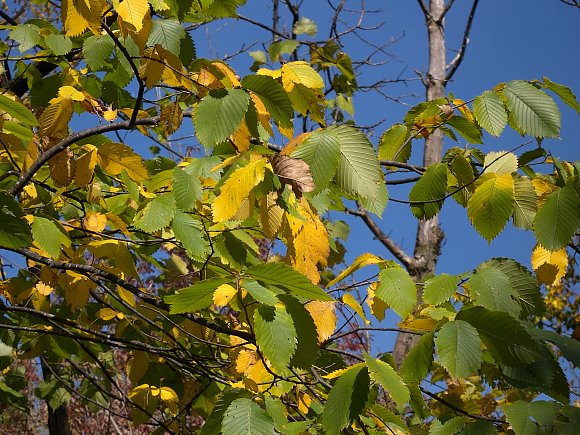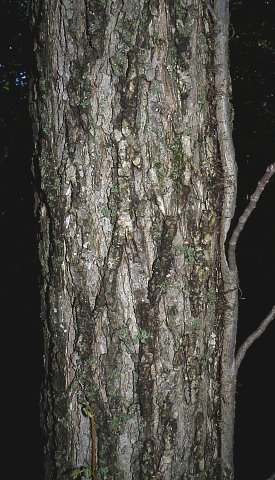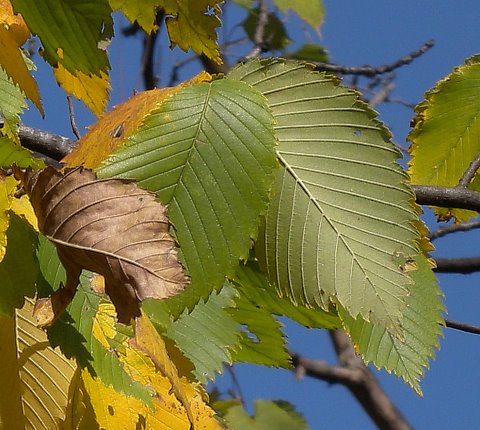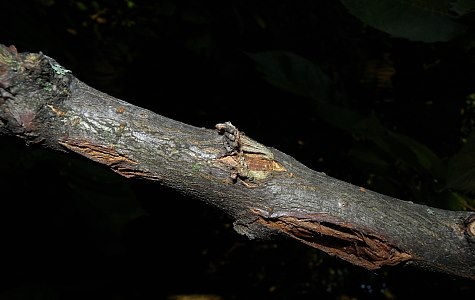
Toward the tips of last year's branches, perfect flowers develop in small clusters of 3-5. There are several drooping flowers per cluster; their pedicels are about ½" long. Individual flowers are about 1/8" across, consisting of a short calyx with 7-9 lobes, an ovary with a divided style, and 7-9 stamens. The calyx is typically reddish green, while the anthers are red (but becoming dark-colored with age). These flowers bloom during early to mid-spring for about 1-2 weeks; they are cross-pollinated primarily by the wind. The flowers are replaced by flattened single-seeded samaras about 1/3" (8 mm.) long and a little less across; they are ovate in shape, except for notches at their tips. The samaras have long hairs along their margins (ciliate), otherwise they are hairless. In the center of each samara is an ellipsoid seed that is somewhat flattened; it is surrounded by a membranous wing. At maturity during the late spring or early summer, the samaras usually become light tan (sometimes they are reddish). The samaras are distributed by the wind. In moist areas, the woody root system is shallow and spreading, but in dry areas it is more deep and develops a taproot. During the autumn, leaves turn yellow before falling to the ground.
Cultivation: The preference is full sun to light shade, moist to mesic areas, and fertile loamy soil. However, American Elm will adapt to drier areas and it can tolerate a wide range of soil types,
 including those that contain clay, silt, or sand. Temporary flooding is tolerated during the winter dormancy period, otherwise good drainage is required. Because of this tree's vulnerability to Dutch Elm Disease, Phloem Necrosis, and other problems, it tends to be short-lived and usually fails to reach its mature size. It can be propagated by leaf bud cuttings.
including those that contain clay, silt, or sand. Temporary flooding is tolerated during the winter dormancy period, otherwise good drainage is required. Because of this tree's vulnerability to Dutch Elm Disease, Phloem Necrosis, and other problems, it tends to be short-lived and usually fails to reach its mature size. It can be propagated by leaf bud cuttings.Range & Habitat: While there has been some population decline because of disease organisms, the native American Elm is still common within Illinois; it has been found in every county (see Distribution Map). Habitats include moist to mesic deciduous woodlands, savannas, woodland openings, woodland borders, wooded terraces along major rivers, flatwoods in upland areas, shaded banks of rivers and streams, higher ground in swamps, fence rows, and roadsides. Today, American Elm is found primarily as an understory tree in both higher quality habitats and disturbed areas. At one time, it was an important canopy tree in deciduous woodlands throughout the state, particularly in bottomland areas. Some older trees are still found in isolated urban areas. Prior to the mid-20th century, American Elm was often used as a landscape tree along streets.
Faunal Associations: Even though the florets are primarily wind-pollinated, honeybees sometimes collect pollen from them, and these insects may function as minor pollinators (Robertson, 1929). This is possible because the flowers are perfect, rather than unisexual. Other insects feed destructively on the wood, bark, foliage, and sap of American Elm and other elm trees (Ulmus spp.). This latter group includes larvae of wood-boring beetles, leaf beetles, weevils, larvae of bark beetles, plant bugs, stink bugs, aphids, leafhoppers, treehoppers, mealybugs, armored scales, walkingsticks, larvae of various kinds of sawflies, larvae of various kinds of moths, and larvae of the following butterflies: Mourning Cloak (Nymphalis antiopa), Comma (Polgonia comma), and Question Mark (Polygonia interrogationis); see the Insect Table for more information. Some of these insects transmit disease organisms to American Elm: they include the White-banded Elm Leafhopper (Scaphoideus luteolus), which transmits the virus causing phloem necrosis; and the larvae of two bark beetles, European Elm Bark Beetle (Scolytus multistriatus) and Native Elm Bark Beetle (Hylurgopinus rufipes), which transmit the fungus causing Dutch Elm disease. Some vertebrate animals also use these trees as a source of food. They include such species as the American Beaver (wood, bark, branches), White-tailed Deer (twigs), Eastern Cottontail Rabbit (bark of saplings), Eastern Gray Squirrel (samaras), and Fox Squirrel (samaras, buds). Many birds consume the seeds and/or buds, specifically: the Wood Duck, Northern Cardinal, Rose-breasted Grosbeak, Clay-colored Sparrow, Purple Finch, Pine Siskin, American Goldfinch, Black-capped Chickadee, Carolina Chickadee, Yellow-rumped Warbler, House Sparrow, Ruffed Grouse, Wild Turkey, Ring-necked Pheasant, Greater Prairie Chicken, and the now extinct Passenger Pigeon. Sometimes the Yellow-bellied Sapsucker sucks sap from American Elm and other elm trees (Martin et al., 1951/1961; Schorger, 1955; Schwartz, 1945; DeVore et al., 2004).

American Elm is also used as protective cover and nesting habitat for some birds, including the Baltimore Oriole, Common Grackle, Black-capped Chickadee, Carolina Chickadee, Yellow Warbler (small trees), American Redstart, Northern Flicker, Red-bellied Woodpecker, Red-headed Woodpecker, Downy Woodpecker, Hairy Woodpecker, White-breasted Nuthatch, American Robin, and Red-eyed Vireo (Gabbe et al., 2002; DeGraaf, 2002; Homan et al., 1996; Jackson, 1976). Warblers and other insectivorus often forage for insects on American Elm and other elm trees because of the large number of insect feeders that they attract (see Bird Table).
Photographic Location: A woodland opening and woodland border at Busey Woods in Urbana, Illinois.

Comments: This tree is one of the fallen icons of America, but it still lingers in diminished form. It is a reasonably attractive tree with shiny leaves. In the past, the wood was used to make furniture, flooring, crates, hockey sticks, and caskets. The wood is heavy, hard, and strong, but it lacks durability and has a tendency to warp. American Elm can be distinguished from other elms (Ulmus spp.) by considering the following characteristics: 1) its samaras are ciliate along their margins, otherwise they are hairless, 2) the upper surface of its leaves is largely hairless with a smooth to slightly rough texture, 3) on each side of the central vein of a leaf, there are 0-3 lateral veins that become forked toward the leaf margin, 4) a cross-section of the bark on older trees reveals alternating light and dark layers, and 5) its terete twigs never have corky wings. Other elm trees in Illinois fail to satisfy one or more of the above characteristics.